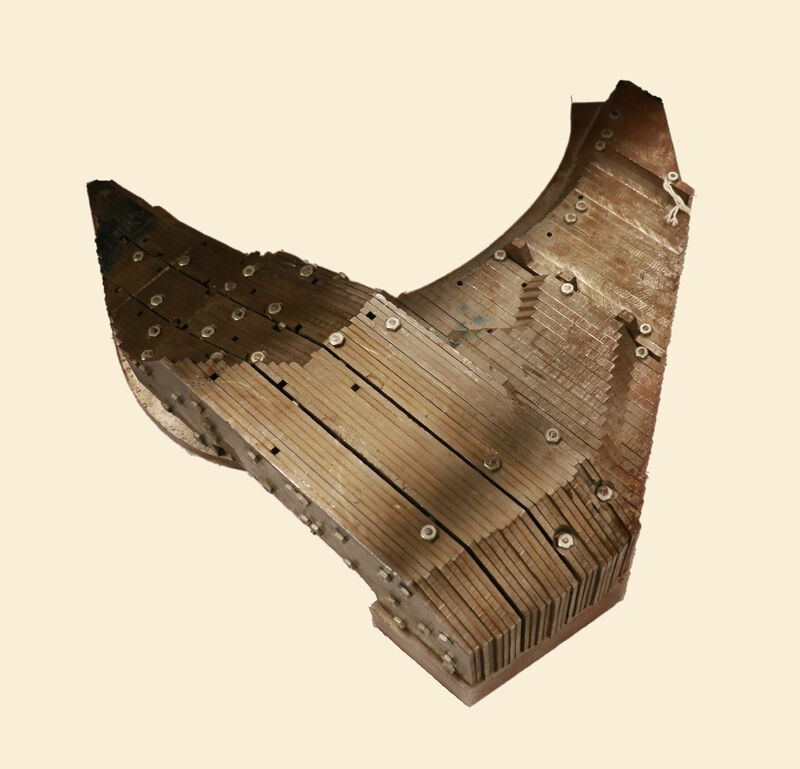TRIUMF
by Victoria JL Fisher
The TRIUMF cyclotron at the University of British Columbia (UBC) was conceived in 1966 as a meson-production facility jointly operated by three west coast universities (UBC, the University of Victoria, Simon Fraser University), hence its name, Tri-University Meson Facility. A cyclotron is a type of particle accelerator that accelerates protons in a spiral formation to energies that can be used to perform experiments, including creating collisions that would form mesons, a subatomic particle that lasts for less than a nanosecond.
TRIUMF was built according to a designed first conceived of at UCLA, and at the time of its construction, could far outstrip any other existing facility in the energies to which it could accelerate particles. One reason for this was a design that involved accelerating hydrogen ions, rather than protons. The other reason was the design of the magnets. In lieu of a single magnet, the TRIUMF cyclotron magnets were conceived as six segments forming the ‘petals’ of two spiral flower-like formations arranged one atop another. Hydrogen ions would pass in a channel between the magnets, accelerated by the magnetic field to extremely high energies before being stripped of their electrons (converting them to protons) and directing them into a beam that could be used for meson production and other experiments.
Each magnet segment was therefore required to be designed to a shape that would create a magnetic field that would perfectly accelerate particles. This process, begun in 1967, involved computer and mathematical modeling and the construction of several models at UBC that allowed the testing of the accelerator at a small scale. The earlier models were built to a scale of 20:1, and small adjustments were made to the shape and arrangement of the models in the form of added or removed metal “shims” to achieve the desired magnetic field.
This artifact is probably one of the twelve total magnet segments from the last of the 20:1 scale models, known as Mk VI-1. In April 1969, a model using this segment was operated successfully, achieving the correct magnetic field. A later model was built to the scale of 10:1 to allow for more precise experiments. All the models appear to have been built onsite at UBC.
The full-scale magnets were constructed by Davie Shipbuilding Ltd., of Lauson Quebec, and were installed in 1972. Other components of the machine were made by EbCo Manufacturing Ltd, of Richmond, BC, which later went onto produce components for the updated cyclotron begun in 1979. The cyclotron did not function at expected energy levels until December 1974, after 492 days of tests and adjustments, in part due to differences between the manufacturing techniques of the magnets in the models and the full-size machine.
TRIUMF’s large cyclotron was rebuilt in the 1980s, and continues to operate. Its flower-like arrangement of six magnetic sectors is visible in its logo.
Timeline
1966 – Inception of cyclotron project, Tri-University Meson Facility (TRIUMF).
1969 – First tests of cyclotron scale model Mk VI-1.
1970 – Davie Shipbuilding Ltd. of Lauson Quebec, wins contract to construct magnets for TRIUMF.
1974 – December. The accelerator is operational at expected energies.
1979 – EbCo Manufacturing Ltd. contracted to build an updated 500 MeV cyclotron at TRIUMF.
1989 – “Advanced Cyclotron Systems Inc. was... formed to develop, promote and sell cyclotrons to the nuclear medicine community.” (“Leaders in Cyclotron Development”)
2003 – “The first 300 μA TR-19 cyclotron, setting the benchmark for PET cyclotron industry, was brought to market. It took ACSI competitors another 15 years to develop a cyclotron with similar parameters.” (“Leaders in Cyclotron Development”)
Selected Sources
“News from abroad – TRUMF” CERN Courier Vol. 8, No. 6 (June 1968): 136-137
Oraas, S. "Techniques Applied to the Design of the TRIUMF Magnet Poles" (University of British Columbia, MSc Thesis, 1970)
Pantalony, D. “Single Object Acquisition Proposal” Canada Science and Technology Museums Corporation, September 20, 2018.
TRIUMF “TRIUMF Annual Report 1969” (February 1970)
TRIUMF “TRIUMF Annual Report 1974” (April 1975)
TRIUMF "Celebrating 40 Years of TRIUMF: 1969-2009" (https://www.triumf.ca/image-galleries/celebrating-40-years-triumf-1969-2009 [24-01-24])
“TRIUMF – Magnet contract placed” CERN Courier Vol. 10 Iss. 3 (March 1970): 88

 Triumf Model Cyclotron Magnet Sector
Triumf Model Cyclotron Magnet Sector TRIUMF
TRIUMF